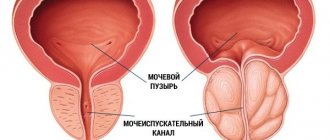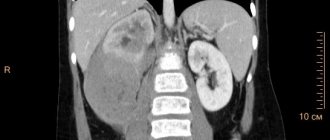Obstetrician-gynecologist, reproductive specialist, member of the Russian Association of Human Reproduction
Perevoznikova
Ekaterina Mikhailovna
11 years of experience
Obstetrician-gynecologist
Make an appointment
Lactostasis is a delay in milk secretion in women during lactation. The cause of this phenomenon in most cases is blockage or spasm of the milk ducts. Other factors can provoke milk retention in the ducts of the mammary glands: wearing tight underwear, injuries, abrupt cessation of breastfeeding.
What is lactostasis?
Despite the fact that lactostasis in a nursing mother is a fairly understandable and common phenomenon, the variety of definitions and approaches to treating this condition is surprising. In this regard, it is necessary to understand what it is - lactostasis. Literally, this is the “standing”, “immobility” of milk in the mammary gland: in the acini of its lobules and ducts. In other words - stagnation of milk. It occurs as an independent condition, for example, after a long break between feedings, and as a symptom of impaired milk flow, or in the structure of inflammation of the mammary glands (mastitis).
Preventive measures
- Put your baby to the breast as often as possible - practice feeding on demand, not according to a schedule.
- Do not pump after feedings unless necessary.
- Feed in different positions.
- Don't get too cold.
- At the first suspicion of lactostasis, seek advice from a specialist.
In the first week after birth, fluid intake (including first courses and fruits) may not be very large, unless there are separate indications for this - up to approximately 800-1,000 ml per day.
If you nevertheless suspect that you have lactostasis, then the first thing you need to do is put your baby to your breast. If the stagnation is small, the baby can resolve it. Experts recommend that if lactostasis occurs, offer the baby a painful breast every hour and keep him there for as long as possible.
If the baby refuses, you can resort to pumping, manual or machine, but be sure to let the baby suck out the remaining milk after that.
Lactostasis - symptoms, types.
Clinically, lactostasis in a nursing mother looks like a local bumpy compaction in the mammary gland without redness. It is accompanied by a painful feeling of fullness and a violation of the outflow of milk (breast milk is not released from one or more ducts at all or comes in droplets). The simple form of lactostasis does not produce a temperature reaction.
Since the metabolism in the lactating gland is significantly increased, the inflammatory reaction with continued stagnation of milk develops very quickly. First, swelling occurs, and the tuberosity of the tissue underneath is masked. The stagnant area becomes even and smooth to the touch. Locally, redness may occur and the temperature of the skin above the seal may increase. When the body temperature rises and a flu-like syndrome appears, it can be assumed that lactostasis has turned into mastitis. The rate of inflammation development depends on the health status of the nursing woman. For some it takes 3 days, for others several hours. According to WHO recommendations, lactostasis is given 24 hours to resolve on its own, then you need to consult a doctor.
A rise in temperature is a very important diagnostic sign for lactostasis. Therefore, it is necessary to measure body temperature correctly! Measurements are taken in the armpit on the healthy side or in the elbow bend if the process is bilateral, and best of all with an infrared thermometer in the forehead area.
How to distinguish lactostasis from mastitis
If stagnation of milk cannot be overcome within 2-3 days, then an inflammatory process begins, which leads to mastitis.
Mastitis occurs when breast tissue becomes inflamed due to infection. It may be accompanied by such severe pain during breastfeeding that you may want to stop breastfeeding, but this should not be done.
Symptoms of mastitis are much more serious:
- breast swelling
- discharge of pus from the nipple
- cracks and abrasions around the nipple
- heat
- chills
With such symptoms, you urgently need to consult a doctor at the clinic. It is impossible to cope with inflammation on your own.
So, what are the signs of simple lactostasis?
This:
- lumpy compaction in the gland against the background of soft tissue;
- feeling of painful fullness;
- unchanged color and temperature of the skin over the induration;
- violation of the outflow of breast milk;
- maintaining good general health.
There is a more severe form of stagnation, which is regarded as a transitional form from simple milk stagnation to mastitis. This is pathological lactostasis . In such lactostasis, the symptoms are characterized by the addition of:
- edema, i.e. the compaction becomes smooth, the tuberosity disappears;
- redness over the lump;
- elevated body temperature up to 38 C.
General health remains satisfactory. When all the above-described symptoms are accompanied by a febrile temperature above 38.5 C and symptoms of intoxication (flu-like syndrome), then mastitis can be diagnosed.
Symptoms of the disease
Signs of lactostasis can be divided into two groups: at an early stage and after inflammation has begun (in advanced form). Immediately after the blockage of the duct appears, the woman feels:
- chest pain;
- compaction in the area of one or more lobes;
- slight tissue swelling.
Departure is paid separately - from 550 rubles
Request a call
Call:
+7 (499) 455-08-05
Sometimes it happens like this: there is pain and swelling of the tissue, but there is no compaction. This happens with a slight lactostasis, which went away on its own. For example, milk stagnation occurred at night, and in the morning you fed the baby, and it resolved.
How to understand that inflammation has begun
More advanced lactostasis, which can only be treated with the help of a specialist, is often accompanied by a pronounced inflammatory process. Its symptoms:
- skin redness;
- increased body temperature;
- severe pain;
- bad feeling;
- heaviness in the chest;
- feeling of fullness of the gland.
If you have lactostasis, then the temperature will remain at 37-37.5 degrees. If it becomes higher, then this is a sign of the development of infectious mastitis. After the lobes and ducts are emptied, the temperature will drop within a few hours.
What causes milk stagnation?
Blockage of the duct.
The most common cause of lactostasis in a nursing mother is blockage of the milk duct. It can be located on the surface of the nipple and be visible to the naked eye. This blockage looks like an inflated white lump under a leathery film. This is the simplest case that a child can handle while sucking, or the woman herself can carefully open it with a sterile needle (for example, from a syringe). More often, blockages are located in the fissures (folds or cracks) of the nipple and require experience in identifying and removing them. Or the most difficult option is deep intraductal blockages. Restoring the patency of the duct, in this case, requires the doctor to have the skill to identify and eliminate blockages and use a special pumping technique.
Blockages occur: Superficial:
- with long breaks between feedings;
- if the nipple is injured during improper sucking or unsuitable underwear.
Deep:
- when receiving excess calcium from food (for example, from fermented milk products);
- due to the individual anatomical structure of the ducts (small caliber, tortuosity, interweaving, kinks);
- in the presence of sluggish inflammation due to chronic infection (fungal or bacterial).
Compression of the ducts.
The next most common cause of milk stagnation is compression of the ducts. It could be:
- internal - inflammatory edema, postpartum engorgement;
- external.
Internal compression. It occurs when swelling of the breast tissue occurs. It may be a consequence of inflammation in neighboring areas of the breast, or due to engorgement when milk comes in.
Inflammation. Inflammatory edema spreads to healthy tissue and compresses the ducts, thereby reducing their lumen, up to its complete closure. Newly produced breast milk remains in the lobules and expands them.
Engorgement. When milk comes in after childbirth, total swelling of the mammary gland often occurs. It comes in varying degrees of severity: from small and soft to tight and intense. In severe cases, the breast becomes so dense and painful that the nipple is completely smoothed out, women cannot lower their arms, put on underwear, and touching the breast causes severe pain. Feeding and pumping becomes impossible. Obviously, in such cases milk is completely blocked in the lobules, but its production continues, and the woman needs fairly prompt help.
External compression. The name, in this case, itself explains the mechanism of impaired milk outflow - this is mechanical compression of the soft tissues of the gland from the outside. This situation occurs when:
- wearing incorrectly selected underwear (tight or too loose);
- lack of supportive underwear, especially for large breasts;
- uncomfortable position during feeding;
- prolonged compression of the gland, for example, during sleep or massage while lying on the stomach;
- when performing intense manual exercise or housework (long vacuuming, mopping, etc.).
LACTOSTASIS: causes, mechanism of development, treatment and prevention
Home > Articles > LACTOSTASIS: causes, mechanism of development, treatment and prevention
Lactostasis is a consequence of dysfunction of the mammary glands in women during breastfeeding between the production and release of milk, leading to stagnation of milk.
Lactostasis is considered by many experts as a quantitative discrepancy between increased or often normal milk production and its insufficient outflow.
Make an appointment with a mammologist.
CAUSES OF LACTOSTASIS
I. Increased milk secretion
Overproduction is when more milk is produced than the baby needs. Typically, normalization between milk production and milk flow occurs within the first 2 weeks after the birth of the baby.
II. Anatomical and physiological factors of lactostasis
1. Variants of the structure of the mammary glands. This applies primarily to women with large, sagging breasts. The child cannot completely empty the milk ducts, which leads to the formation of stagnation of milk.
2. Abnormal structure of the nipple of the mammary gland. Unpronounced, especially flat, nipples do not allow the child to grasp and hold the nipple correctly. In this case, the breastfeeding mother's mammary glands are not emptied enough, which can ultimately lead to lactostasis.
3. Anatomical structure of the ducts of the mammary glands. With narrow and tortuous milk ducts, especially their combination, the likelihood of developing lactostasis sharply increases.
4. “Milk plug.” Blockage of one or more milk ducts by a “milk plug” leads to a mechanical cessation of milk outflow and is the cause of lactostasis during breastfeeding.
5. Cracks in the nipple and areola. Damage to the integrity of the skin on the nipples of the mammary glands leads to difficulty in breastfeeding, even to the point of abandonment, and the likelihood of developing not only lactostasis increases.
6. Diffuse fibrocystic mastopathy. It has been noted that with mastopathy, fibrous tissue grows in the mammary glands, which has a very dense structure and can compress the ducts of the mammary glands, disrupting the outflow of milk during breastfeeding.
7. Injuries of the mammary glands. Various types of injuries (bruises, impacts due to falls, etc.) of the mammary gland lead to disruption of the morphology and functioning of the ductal lobular system and the formation of milk stagnation.
8. Hypothermia of the mammary glands. Severe hypothermia leads to the fact that the milk ducts are greatly narrowed, which greatly complicates the outflow of milk and can contribute to the development of lactostasis.
III. Behavioral factors in the occurrence of lactostasis
1. Incorrect attachment of the baby to the breast, when not all lobules are in the same “physiological position,” can lead to compression of the milk ducts. This leads to the rapid development of not only lactostasis, but also to injury to the nipple with the appearance of cracks.
2. Insufficient breast emptying, as well as irregular breast emptying, can most likely result in stagnation of milk.
Too long periods of time during breastfeeding, exceeding 3 hours, often lead to congestion.
3. Additional pumping of milk can lead to additional milk production, which the child cannot handle, which can lead to lactostasis.
IV. Other factors
1. Tight underwear. Wearing tight underwear, especially a bra, leads to pinching of the milk ducts and stagnation of milk.
2. Stress and lack of sleep can lead to physiological narrowing of the ducts, disruption of outflow, resulting in areas of milk stagnation in the mammary glands.
3. Heavy physical labor can lead to pinching of the milk ducts, making it difficult for a nursing mother to outflow milk, which can result in lactostasis.
4. Sleeping on your stomach can also lead to compression of the milk ducts and stagnation of milk.
MECHANISM OF LACTOSTASIS DEVELOPMENT
The formation of lactostasis is typical for primiparous women in the first weeks and months after childbirth. Moreover, lactostasis in the first days after childbirth is pathogenetically different from milk stagnation during regular breastfeeding.
In the first days after birth, a rapid decrease in the level of placental steroids against the background of a sharp increase in prolactin secretion leads, on the one hand, to the accumulation of milk in the alveoli of the mammary gland, and on the other hand, causes swelling of the mammary gland tissue and compression of its ducts. The situation is complicated by the lack of stimulation of the nipple-areolar zone, early attachment of the baby in the first hours after birth and pumping of the mammary glands, which is collectively reflected in low production of oxytocin and paresis of the milk ducts. As a result of a lack of oxytocin, milk stagnates in the alveoli and does not enter the milk ducts. All these phenomena ultimately lead to swelling, engorgement and soreness of the mammary glands.
It has been established that, regardless of the cause of its occurrence, uncontrolled lactostasis pathogenetically proceeds according to the standard pattern and, as a rule, ends in mastitis.
TREATMENT OF LACTOSTASIS
Therapy for lactostasis is complex and includes changing the regimen and frequency of feeding, and conservative therapy.
Regimen and methods of breastfeeding for lactostasis.
Alternate breastfeeding should be abandoned for a while in favor of feeding with both breasts every 1.5–2 hours; if necessary, the feeding interval should be reduced to an hour. Night feedings are mandatory.
Role, pumping technique.
Expressing remains an important part of the fight and with lactostasis it should be carried out not only carefully, but also technically correctly.
For this purpose, to overcome lactostasis, a breast pump has shown its effectiveness, before using which it is necessary to carry out a soft and gentle massage of problem areas and thermal procedures.
With lactostasis, pumping is carried out until a state of comfort, and not until the “last drop,” so as not to increase the production and flow of milk.
Rules for pumping during lactostasis. You should grasp the mammary gland with the seal with the same hand so that it lies on the palm, the thumb is on top, the rest support and lift it. In this case, the milk will flow painlessly and the nipple will not be injured. At the same time, with the other free hand, the area of compaction is massaged in the direction from the periphery to the center of the mammary gland, freeing it from milk.
Expressing is made easier by taking a No-Spa tablet 20–30 minutes before feeding, a warm heating pad applied to the breast, and expressing after feeding the baby. You can carry out these activities and do it under a warm shower.
It should be noted that strong compression of the mammary glands during rough expression can lead to trauma to the lobular-ductal system of the mammary glands and can lead to the development of mastitis.
Changing the position of the child and mother during feeding with lactostasis
With lactostasis, you need to use poses that help release the mammary gland from milk in those areas where it has stagnated. In such cases, hand feeding is often effective.
Breast massage
When performing a massage of the mammary glands, all movements should be soft, smooth, in the direction from the base of the breast to the nipples.
Heat and cold treatments
To achieve the effect, before feeding and pumping, it is recommended to take a warm shower or apply warm, damp wipes to the mammary glands, which helps improve milk flow. After feeding, cold applications are used for 10–15 minutes, which reduces milk production.
Ointments and compresses
The goal of all ointments and compresses is to reduce swelling of the mammary gland and improve milk flow, relieving spasm of the milk ducts. Magnesium sulfate, ointments are used: traumeel C, malavit.
Ultrasound Applications
To relieve lactostasis, ultrasound is used, usually 3-4 procedures are prescribed, the breast gland is massaged over the lump using the sensor of an ultrasound device for physiotherapy, after which the milk must be expressed immediately.
Drug reduction of milk secretion
Treatment regimen for lactostasis 1. Bromocriptine (Parlodel) is prescribed 2.5 mg 2 times a day. within 2–3 days. Gentle pumping of the mammary glands is added 2–3 hours after starting to take the drug for 1–2 days, breastfeeding – after 1 hour.
Treatment regimen for lactostasis 2. Dostinex 1 mg is prescribed, ? table 1 time a day for 1–2 days, breastfeeding – every 1 hour.
Treatment regimen for lactostasis 3. Cutaneous applications of 2.5 g of 1% progestogel gel once a day for 2 days, additionally expressing the mammary glands - 15-20 minutes after application, breastfeeding - after 1 hour.
Optimal combination: bromocriptine + progestogel, dostinex + oxytocin.
Oxytocin for lactostasis
In case of severe lactostasis, you can use sublingual administration of the drug, 2 drops per 15 minutes. before feeding. In rare cases, intramuscular injection of oxytocin is used in a single dose of 0.2–0.3 ml.
Antibiotics are not indicated for lactostasis.
NSAIDs. Taking paracetamol and other nonsteroidal anti-inflammatory drugs (NSAIDs) is possible, especially with severe pain, and does not affect breastfeeding.
Drug suppression of lactation
If there is no expected effect within 1.5–2 days, a thorough differential diagnostic procedure should be carried out to exclude lactation mastitis. For this purpose, it is necessary to repeat an ultrasound of the mammary glands with a puncture biopsy of the problem area of the mammary gland with a thick needle.
If the use of all measures for lactostasis is ineffective, moreover, there is a threat of development or mastitis has developed, the question arises of a complete cessation of lactation.
Bromocriptine is better known and most often used in practice for this purpose according to the following regimen: 2.5 mg 2-3 times a day for 3-5 days. Lactation stops within a couple of days when taking the tablets according to the regimen.
Of the modern drugs for this purpose, Dostinex is used in a dosage of 1 tablet. 1 time per day for 2 days. Lactation usually stops within 1 day. Rarely, due to ineffective suppression of lactation, it is necessary to extend the course of treatment to 3 days.
PREVENTION OF LACTOSTASIS
1. The correct position of the baby at the breast allows a nursing woman to avoid many problems and complications.
Signs of correct attachment:
- Silence during feeding (except for the sounds accompanying the baby's swallowing of a portion of milk). Other sounds, in particular “clicking” or “smacking”, indicate a broken vacuum and insufficiently effective sucking.
- The child's mouth is wide open (angle at least 130–140?), the chin is pressed tightly to the mother's chest, the lower lip is completely inverted, the tongue covers the lower gum and is visible in the corner of the mouth.
- It is not painful for the mother to feed; at the end of feeding, the nipple is evenly extended and has the shape of a cylinder. A deformed nipple indicates an impaired latching technique.
2. Criteria for correct sucking:
- The baby sucks slowly, rhythmically, deeply.
- There is no drawing in of air (with sound) and swelling of the cheeks.
- The baby's ears move rhythmically while sucking.
3. Signs of improper sucking:
- The child sucks (“chews”) only the nipple; The newborn's tongue interacts only with the tip of the nipple.
- The lips (gums) press only on the nipple, and not on the entire areola.
- The lips are sucked into the oral cavity.
4. Feeding on demand of the child. It is necessary to attach him to the breast for any reason, giving him the opportunity to suckle when he wants and as much as he wants. This is very important not only for satiating the child, but also for his feeling of comfort and security.
5. The duration of feeding is regulated by the child. You should not take your baby off the breast before he releases the nipple on his own. This can lead to insufficient emptying of the breast.
6. Night feedings of the baby ensure stable lactation and protect the woman from stagnation of milk. In addition, night milk is considered the most complete.
7. When breastfeeding separately with two breasts in turn, the time interval between feedings should not exceed 3 hours, including the night period. If congestion occurs, the interval should be reduced to 2 hours, or even switch to breastfeeding with both breasts.
8. If there is a tendency to develop lactostasis, each feeding should be carried out from both mammary glands, while finishing feeding with the same breast with which you started. This feeding technique promotes better emptying and drainage of the mammary glands, eliminates injury to the nipples, and also prevents the baby from swallowing air.
9. You should not transfer the baby to the second breast before he has sucked the first breast, this can lead to stagnation of milk.
10. If there are cracks, you should use products that promote rapid healing (Bepanten, Purelan 100, Avent, etc.)
11. To prevent the formation of cracks, frequent washing of the breasts before and after feeding should be avoided.
Frequent breast washing leads to the removal of the protective layer of fat from the areola and nipple, which leads to the formation of cracks. The mammary glands should be washed no more than once a day during a hygienic shower. If a woman showers less often, then even in this case she should wipe with a damp cloth without using soap before feeding.
12. Additional milk expression. With properly organized breastfeeding, milk is produced exactly as much as the baby needs, so there is no need to pump after each feeding. The need to pump appears when the child’s suction is insufficient and/or milk stagnation occurs.
Principles of treatment of lactostasis.
If lactostasis is associated with a long break between feedings, then it may be enough to feed the child by choosing a position. For symptomatic lactostasis, treatment consists of eliminating the underlying disease:
- If there are blockages, the doctor removes them, then expresses the stagnant breast milk. After the procedure, prevents inflammation.
- If lactostasis is associated with internal compression by edema or engorgement, then the very first and most accessible method that the woman herself can use is cooling the breasts after feeding. To achieve a more significant result, the doctor uses special medications and physiotherapy.
- If the swelling is caused by inflammation, then after the milk flow is restored, the main emphasis of treatment is on eliminating its causes.
- For engorgement, it is also used
.
Causes of lactostasis
This disease can appear due to irregularly shaped nipples, cracks on them, which complicate the feeding process. Also, the causes of lactostasis may lie in the refusal of natural feeding and the transition to artificial feeding. The reasons may be stress, increased physical activity, which can lead to spasms of the milk ducts. If you have ever seriously injured or bruised your chest, this may subsequently lead to this disease. Your baby needs to be placed correctly at the breast so that he or she can suckle effectively. Insufficiently emptied breasts can become inflamed. During feeding, do not squeeze the mammary glands with tight clothing, and also try not to sleep on your stomach. Signs of lactostasis may lie in hypothermia or prolonged exposure to a draft. The mammary glands may become cold. Large breasts that sag during feeding may make it difficult for milk to flow out. This can also lead to this disease.
Traditional methods of treatment for lactostasis.
Cabbage.
The most popular recommendation is to apply a cabbage leaf. From the point of view of evidence-based medicine, this method does not provide any other effect than a short-term cooling effect. Cabbage juice does not have anti-edema, anti-inflammatory properties and is not able to penetrate deeper than the surface layers of the skin. And it certainly cannot affect the blockage of the duct at all. But in trying to help themselves in such an ineffective way, nursing mothers waste precious time and delay visiting a doctor.
Cottage cheese and dough.
These products were used for the same purpose as cabbage - cooling, and also without the desired effect. But in this case, there is a risk of additional bacterial load on stagnant areas. If there is damage to the skin of the chest, the inflammation will quickly become infectious.
Honey.
Honey was used for the purpose of warming, which may be appropriate during recovery from lactostasis caused by a long break between feedings, when pain persists. But its strong irritating effect on the skin makes honey unsuitable for use on the lactating gland. To warm up, it is much preferable to use dry heat (heated diaper) or a warm shower before feeding.
Thus, folk remedies for lactostasis should be considered only in the historical context of the development of assistance to nursing women.
Prevention methods
It is necessary to prevent the occurrence of lactostasis not only because of the discomfort, but also because it can lead to the formation of mastitis in the future. To prevent this from happening, you need to:
- make breastfeeding very frequent, do not limit feeding and offer the breast when the baby demands. He should spend as much time at the breast as he wants. If there is a lot of milk that has stagnated, it is uncomfortable for him to latch onto the breast;
- look for positions that are comfortable for feeding, and if necessary, constantly change them. The baby should have access to milk from all parts of the breast;
- there is no need to squeeze the breasts too much during feeding to prevent blockage and compaction;
- try to avoid sleeping on your stomach, preferably sleeping on your side or back;
- it is important to choose the right bra so that it does not squeeze the chest and does not cause discomfort;
- avoid injury and hypothermia of the chest.
The above measures will help in the prevention of lactostasis. Preventing a disease is much better than fighting it in the future. This is why visiting a doctor in a timely manner is extremely important. You can make an appointment with our doctors online on the clinic’s website. It shows the opening hours and addresses of all six clinics. Among them, it is easy for the client to choose the one that will be more convenient to get into. To contact representatives of the clinic, there is a single number +7 495 790-35-53. By contacting it, you can ask your questions.
Self-help for lactostasis.
So, what can be recommended to a nursing woman with lactostasis while she is waiting for help from a doctor:
- continue to breastfeed the baby or pump, if possible;
- do not limit drinking;
- immediately before feeding or pumping, briefly warm the breasts in the shower or with a heated diaper;
- After feeding, cool the stagnant area for 15-20 minutes, for example, with a bag of frozen vegetables (peas, corn) through a layer of terry towel. Not ice!;
- taking antipyretic drugs as prescribed by a doctor.
Most importantly, do not stop feeding! The breasts must be emptied of milk. Adequate feeding and careful pumping usually eliminate congestion. If you cannot eliminate lactostasis on your own, it is important to promptly consult a lactation specialist in order to prevent the development of mastitis. If you need urgent qualified help, call us, we will definitely help!
The concept of lactostasis
During breastfeeding, complications with milk and stagnation in the breast may occur.
This condition is called lactostasis. When the ducts do not release milk for a long time, it leads to the formation of a milk plug. With a long-term inflammatory disease, purulent mastitis may occur. The disease begins in acute form a few days after childbirth, often in women who are not breastfeeding.
Prevention of lactostasis
It is imperative to combat lactostasis, as it brings discomfort to a woman and can lead to mastitis, that is, inflammation of the breast tissue. It is necessary to arrange prevention and fight it, at the same time, preventing a sharp increase in the amount of milk. In the first seven days after giving birth, try not to eat a lot of fruit and drink a lot of water. Another means of prevention is to constantly attach the baby to the breast. As soon as the baby wants to eat, he needs to be fed immediately. If a woman has significant stagnation of milk, it may be difficult for the baby to drink it. In this case, you need to express small portions of it to relieve pain in the nipple area. It is very useful to massage your breasts sometimes. The massage should be carried out in a circular motion from the periphery to the center of the chest. If one breast hurts more, then the baby should be applied to it more often. This should help you.








